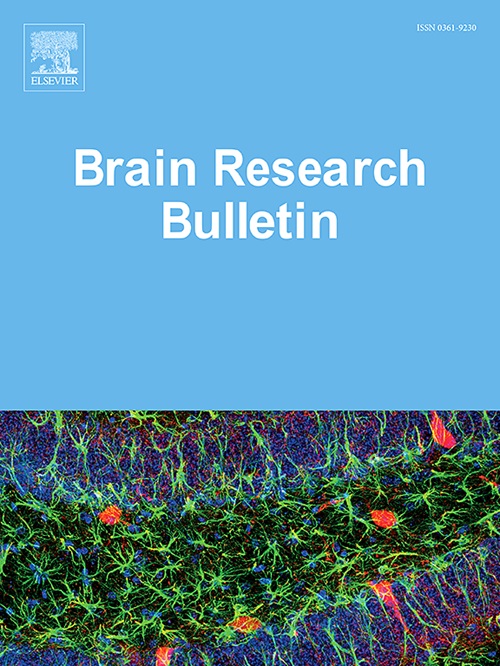Arc在癫痫和抑郁合并症模型大鼠海马中的表达模式
IF 3.5
3区 医学
Q2 NEUROSCIENCES
引用次数: 0
摘要
与癫痫和抑郁症(EAD)共病相关的两个关键因素,活性调节细胞骨架蛋白(Arc)和荷马蛋白同源物1 (Homer1),之前由我们的团队通过生物信息学方法确定(Yu etal ., 2022)。通过动物实验验证了Arc和Homer1的表达。方法6周龄雄性无致病性Sprague Dawley大鼠(体重200 ± 20 g)腹腔注射氯化锂(LiCl)-匹罗卡品诱导癫痫持续状态(SE)。30 min后腹腔注射地西泮终止SE,视频监测大鼠自发性SE 2周。对照组(Con组)注射等剂量的无菌生理盐水。随后,根据lcl -pilocarpine诱导的慢性癫痫大鼠模型第14天强迫游泳试验的静止时间,选择EAD大鼠(EAD组)。其余大鼠分为癫痫组(EP组)。抑郁样行为通过蔗糖偏好、野外和强迫游泳测试进行评估。测定licl -匹罗卡品致痫后14、28天大鼠体重、蔗糖偏好率、开场试验总距离、平均速度、直立次数、强迫游泳试验不动时间。对EAD组和EP组大鼠进行2周的视频监测,记录慢性自发性癫痫发作的频率、程度和持续时间。比较EAD组和EP组的癫痫发作情况。采用实时荧光定量PCR和western blot检测各组海马组织中活性调控细胞骨架蛋白(Arc)和荷马蛋白同源物1 (Homer1)的表达。免疫荧光(IF)法检测各组海马组织中Arc的荧光强度。结果与对照组和EP组相比,EAD组大鼠在第28天体重明显下降,第14天和第28天蔗糖偏好率明显降低,静止时间明显延长,总行程、平均速度、直立次数明显减少。在EAD组和EP组之间,癫痫发作的次数、程度和持续时间没有显著差异。同时,与Con和EP组相比,EAD组海马组织中Arc的表达水平显著降低;而Homer1的表达水平无明显变化。IF结果显示,Arc主要在细胞质中表达,EAD组海马CA1、DG和CA3中Arc的荧光强度低于Con和EP组。结论EAD大鼠海马组织中Arc的表达明显降低,提示Arc与EAD有关。本文章由计算机程序翻译,如有差异,请以英文原文为准。
Expression pattern of Arc in the hippocampus of a rat model of epilepsy and depression comorbidity
Background
Two key factors associated with the comorbidity of epilepsy and depression (EAD), activity regulated cytoskeletal protein (Arc) and homer protein homolog 1 (Homer1), were previously identified by our group through bioinformatics methods (Yu et al., 2022). The expression of Arc and Homer1 were verified through animal experiments.
Methods
Six-week-old male specific pathogen-free grade Sprague Dawley rats (weighing 200 ± 20 g) received intraperitoneal injection of lithium chloride (LiCl)-pilocarpine for status epilepticus (SE) induction. SE was terminated after 30 min by intraperitoneal injection of diazepam, and spontaneous SE in rats was monitored by video for 2 weeks. The control group (Con group) was injected with an equal dose of sterile normal saline. Subsequently, EAD rats (EAD group) were selected from rat models of LiCl-pilocarpine-induced chronic epilepsy according to the immobility time of the forced swimming test on day 14 after LiCl-pilocarpine induced epilepsy. The remaining rats were included in the epilepsy group (EP group). Depression-like behaviors were evaluated using sucrose preference, open-field, and forced swimming tests. Body weight, sucrose preference percentage, the total distance of the open-field test, the average speed, the number of upright times, and the immobility time of the forced swimming test were assessed 14 and 28 days after LiCl-pilocarpine induced epilepsy. Rats in the EAD and EP groups were monitored by video for 2 weeks, and the frequency, grade, and duration of chronic spontaneous epileptic seizures were recorded. Epileptic seizures were compared between the EAD and EP groups. The expression of activity-regulated cytoskeletal protein (Arc) and Homer protein homolog 1 (Homer1) in the hippocampus of each group was detected by real-time quantitative PCR and western blot analysis. The fluorescence intensity of Arc in the hippocampus of each group was detected by immunofluorescence (IF) assay.
Results
Compared with the Con and EP groups, rats in the EAD group exhibited a decreased body weight on day 28, a significant decrease in sucrose preference percentage on days 14 and 28, significantly extended immobility time, and significantly reduced total travel, average speed, the number of upright times. No significant differences in the number, grade, and duration of seizures were observed between the EAD and EP groups. Meanwhile, the expression level of Arc in the hippocampus was significantly decreased in the EAD group compared with the Con and EP groups; however, the expression level of Homer1 showed no significant change. IF results showed that Arc was mainly expressed in the cytoplasm, and the fluorescence intensity of Arc in hippocampal CA1, DG, and CA3 was lower in the EAD group than in the Con and EP groups.
Conclusions
The expression of Arc in the hippocampal tissue of EAD rats is significantly decreased, suggesting that Arc is associated with EAD.
求助全文
通过发布文献求助,成功后即可免费获取论文全文。
去求助
来源期刊

Brain Research Bulletin
医学-神经科学
CiteScore
6.90
自引率
2.60%
发文量
253
审稿时长
67 days
期刊介绍:
The Brain Research Bulletin (BRB) aims to publish novel work that advances our knowledge of molecular and cellular mechanisms that underlie neural network properties associated with behavior, cognition and other brain functions during neurodevelopment and in the adult. Although clinical research is out of the Journal''s scope, the BRB also aims to publish translation research that provides insight into biological mechanisms and processes associated with neurodegeneration mechanisms, neurological diseases and neuropsychiatric disorders. The Journal is especially interested in research using novel methodologies, such as optogenetics, multielectrode array recordings and life imaging in wild-type and genetically-modified animal models, with the goal to advance our understanding of how neurons, glia and networks function in vivo.
 求助内容:
求助内容: 应助结果提醒方式:
应助结果提醒方式:


